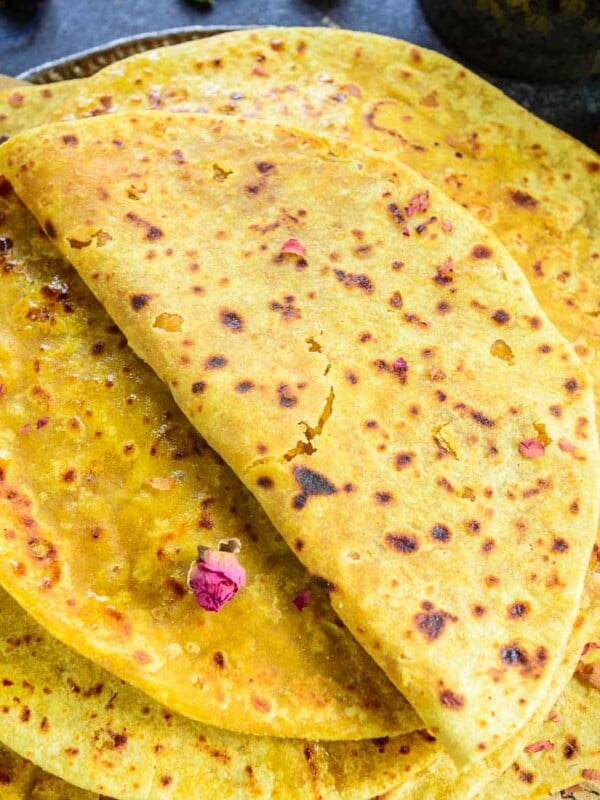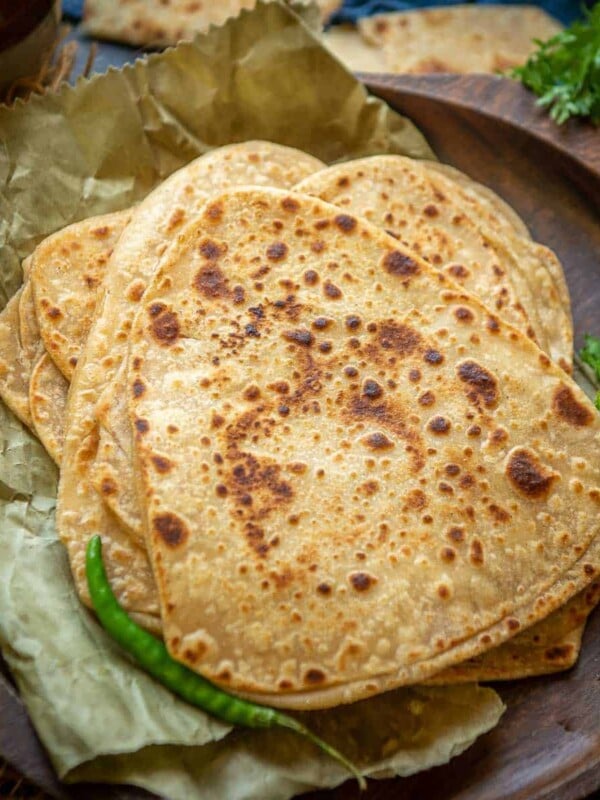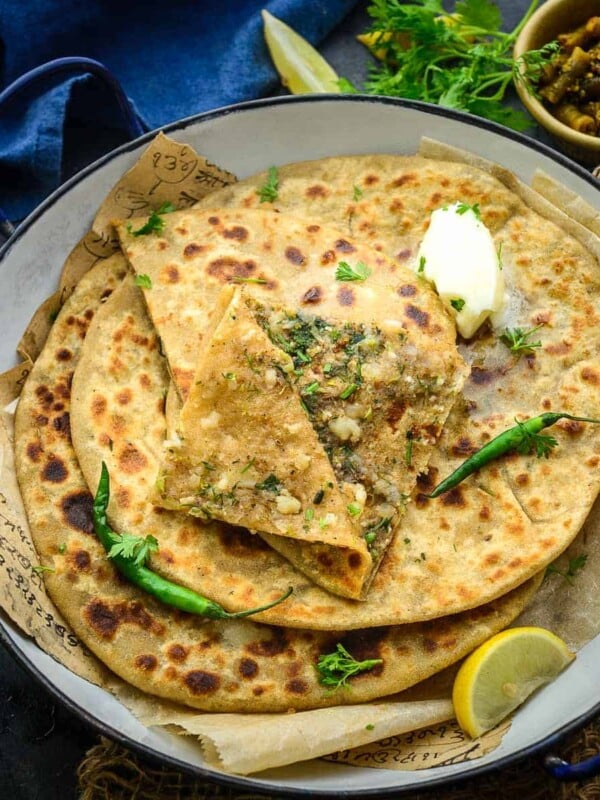Sindhi Koki
A popular dish from Sindhi cuisine, Sindhi Koki is a flatbread with a fabulous taste and interesting texture. It is a breakfast dish made using wheat flour, besan, spices, and herbs.
Do try Sindhi Kadhi and Aloo Tuk if you like Sindhi cuisine.

Sindhi is a community in India known for its love of food. When I was growing up, I had a Sindhi friend who used to bring Koki in her lunch box. The bread was quite different from what we were used to eating. She told me the process also differs from regular parathas or theplas.
I forgot about this bread for many years, then, one day, while going through old pics, I came across my friend’s picture. That reminded me of all the amazing Sindhi food she used to get in her tiffin. After some research on the internet, I made this recipe and was immediately transported to the good old days!
About Sindhi Koki
Sindhi Koki is a popular dish in Sindhi Cuisine. It is a flatbread made by preparing a wheat and gram flour dough mixed with finely chopped onions, aromatic spices, and cilantro.
This bread is not only famous for its fantastic taste but also for its texture. A bite of Sindhi koki is slightly crispy on the outside and soft on the inside.
This vegan bread gets its texture from a unique cooking method, where the dough is rolled and cooked twice.
Koki is traditionally a breakfast dish but can be served anytime with yogurt, pickle, or curry.
Ingredients
Flour – You will need whole wheat flour (gehu ka atta) and gram flour (besan, chickpea flour).
Onions – I used red onions, but yellow onions, white onions, or shallots all work fine.
Green Chilies – Adjust the chilies to your taste and preference. If you are making it for kids, you can skip adding them.
Spices – To enhance the flavor of this Indian bread, add everyday spices such as coriander powder, turmeric powder, red chili powder, salt, and dry pomegranate seed powder (anardana powder).
These ingredients add a sour and spicy flavor, making this simple bread even more delicious.
Kasuri Methi – This enhances the flavor of Koki instantly, so do not miss out on Kasuri methi.
Others – You will also need cumin seeds, carom seeds (ajwain), cooking oil, and cilantro (fresh coriander leaves).
How To Make Sindhi Koki
Add the following ingredients to a large bowl (or parat) and mix well to make a crumbly mixture.
- 2 cups whole wheat flour
- 2 tbsp gram flour
- ½ cup finely chopped onions
- 1 tsp salt
- 1 tsp coriander powder
- ¼ tsp turmeric powder
- 1 tsp red chili powder
- 1 tsp cumin seeds
- ½ tsp carom seeds
- 1 tsp dry pomegranate seed powder
- 1 tbsp Kasuri methi
- 1 tsp finely chopped green chilies
- 2 tbsp finely chopped cilantro
- 2 tbsp cooking oil


Leave the mixture for 10 minutes. The onions will leave the water during this time.
Mix the flour mixture with your fingers.

Now add water (approx ¾ cup) little by little and knead to make a stiff dough. Do not over-knead this dough. The dough does not have to be smooth.


Divide the dough into 6 equal parts and roll them to make balls. The amount of dough for koki is more than that we take for roti or paratha.

Dust and roll a dough ball using a rolling pin into a 3-4 inch disc.

Heat a skillet over medium heat.
Transfer the koki to the hot skillet and cook for 2 minutes on each side.

Remove the koki from the skillet and roll it again to make a 5-6 inch circle. The edges of koki are not smooth; they are cracked up.


Prick the koki using a fork all over.

Transfer it to the skillet and cook on medium heat until brown spots appear on the lower side.

Flip and apply 1 teaspoon oil all over.
Flip again and apply 1 teaspoon oil on another side as well.
Cook from both sides until nice and brown. Keep pressing the koki with the back of a spatula while cooking, especially on the sides.
Serve hot with fresh yogurt and pickle.
Make all the koki in the same manner.
Note – Wipe the skillet with paper tissue after making each koki to remove the burnt dry flour from the skillet.

Pro Tips By Neha
Mix the flour and ghee properly by massaging it generously between your palms until it looks like bread crumbs. This would ensure that the koki is flaky enough.
Whenever you store it for travel, picnic, or lunch box, cool the koki first and then pack them so they remain crunchy and do not become as soft as chapati or paratha.
You Might Also Like
Indian Sweets & desserts
Maharashtrian Puran Poli Sweet
Indian Breads
Plain Tawa Paratha
Indian Breads
Broccoli Paratha Recipe
Craving more? Subscribe to Whisk Affair to get new recipes and a newsletter delivered straight to your inbox! And stay in touch on Facebook, Pinterest, and Instagram for all of the latest updates.

Sindhi Koki Recipe
Ingredients
- 2 cups whole wheat flour (gehu ka atta)
- 2 tablespoons gram flour (besan, chickpea flour)
- ½ cup finely chopped onions
- 1 teaspoon salt
- 1 teaspoon coriander powder
- ¼ teaspoon turmeric powder
- 1 teaspoon red chili powder
- 1 teaspoon cumin seeds
- ½ teaspoon carom seeds (ajwain)
- 1 teaspoon dry pomegranate seed powder (anardana powder)
- 1 tablespoon Kasuri methi
- 1 teaspoon finely chopped green chilies
- 2 tablespoons finely chopped cilantro (fresh coriander leaves)
- 2 tablespoons cooking oil (plus for frying)
Instructions
- Add all the ingredients to a large bowl (or parat) and mix well to make a crumbly mixture.
- Leave the mixture for 10 minutes. The onions will leave the water during this time.
- Mix the flour mixture with your fingers.
- Now add water (approx ¾ cup) little by little and knead to make a stiff dough. Do not over-knead this dough. The dough needs not to be smooth.
- Divide the dough into 6 equal parts and roll them to make balls. The amount of dough for koki is more than that we take for roti or paratha.
- Dust and roll a dough ball using a rolling pin into a 3-4 inch disc.
- Heat a skillet over medium heat.
- Transfer the koki to the hot skillet and cook for 2 minutes on each side.
- Remove the koki from the skillet and roll it again to make a 5-6 inch circle. The edges of koki are not smooth; they are cracked up.
- Prick the koki using a fork all over.
- Transfer it back to the skillet and cook on medium heat until brown spots appear on the lower side.
- Flip and apply 1 teaspoon of oil all over.
- Flip again and apply 1 teaspoon of oil on another side as well.
- Cook from both sides until nice and brown. Keep pressing the koki with the back of a spatula while cooking, especially on the sides.
- Serve hot with fresh yogurt and pickle.
- Make all the koki in the same manner.
- Note – Wipe the skillet with paper tissue after making each koki to remove the burnt dry flour from the skillet.





Amazingly delicious
Turned out really nice and crisp . The double cooking of the dough works well
The picture is mouth watering. I am cooking and learning koki with your blog.
Thank you so much for sharing the recipe. My family loved it!
Why is the dough cooked twice??…. What difference does it make with respect to taste/texture/ looks??
This is how koki is made traditionally. This process make it crispy even from inside.
Came out perfect.. I just added a cup of frozen methi leaves and it was oh so yummy n a nutritious lunch.. thank you for sharing..
Good to know 🙂
Thank you so much for sharing the recipe. My family loved it!
Happy to hear 🙂
These flatbread look incredibly delicious! I adore all those wonderful warming spices in them.
These were really very good Angie